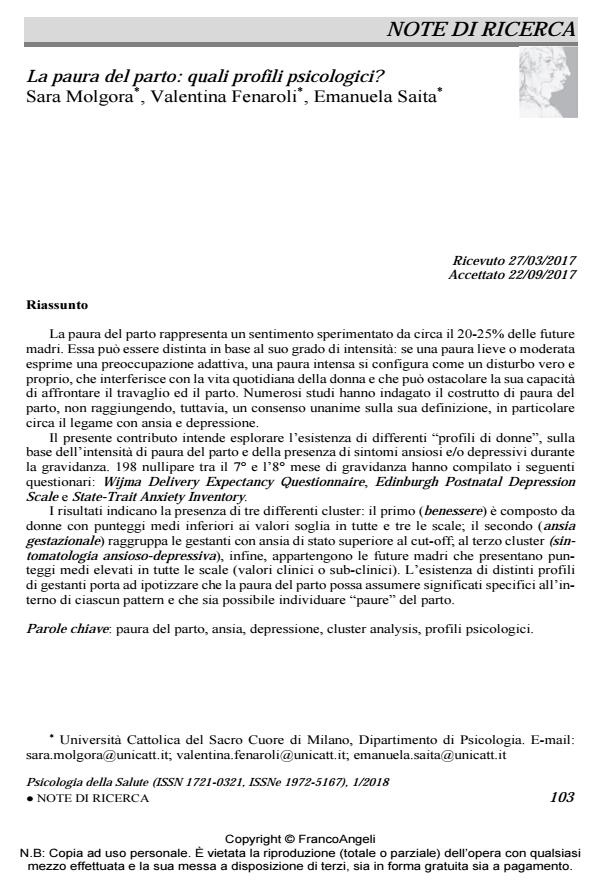Fear of childbirth: what psychological profiles?
Journal title PSICOLOGIA DELLA SALUTE
Author/s Sara Molgora, Valentina Fenaroli, Emanuela Saita
Publishing Year 2018 Issue 2018/1
Language Italian Pages 13 P. 103-115 File size 217 KB
DOI 10.3280/PDS2018-001006
DOI is like a bar code for intellectual property: to have more infomation
click here
Below, you can see the article first page
If you want to buy this article in PDF format, you can do it, following the instructions to buy download credits

FrancoAngeli is member of Publishers International Linking Association, Inc (PILA), a not-for-profit association which run the CrossRef service enabling links to and from online scholarly content.
Fear of childbirth is a feeling experienced by as much as 25% of future mothers. It can be distinguished by its degree of perceived and actual intensity in facing labor. A mild or moderate fear is adaptive, while intense fear has the potential to develop into a full disorder, interfering with the woman’s daily life and with her capacity to face labor. Numerous studies have investigated the construct of fear of childbirth, but have not yet reached a unanimous consensus on its definition, especially as it relates to anxiety and depression. The present research explores the existence of different "women’s ‘profiles’" based on the intensity of fear of childbirth and the presence of anxious or depressive symptoms during the pregnancy. 198 first-time mothers between the 7th and 8th month of pregnancy completed the Wijma Delivery Expectancy Questionnaire, Edinburgh Postnatal Depression Scale, and State-Trait Anxiety Inventory. The results indicated the presence of three distinct clusters. The first cluster, that we call well-being, is composed of women with average scores lower than the threshold values on all three measures. The second, pregnancy anxiety, groups women with a mean state-anxiety score above the cut-off. To the third cluster, anxiety-depressive symptoms, belongs mothers-to-be who have high average scores on all scales. The existence of distinct pregnancy profiles suggests that childbirth can assume specific meanings within each pattern and that it is possible to identify different "fears" of childbirth.
Keywords: Fear of childbirth, anxiety, depression, cluster analysis, psychological profiles.
Sara Molgora, Valentina Fenaroli, Emanuela Saita, La paura del parto: quali profili psicologici? in "PSICOLOGIA DELLA SALUTE" 1/2018, pp 103-115, DOI: 10.3280/PDS2018-001006